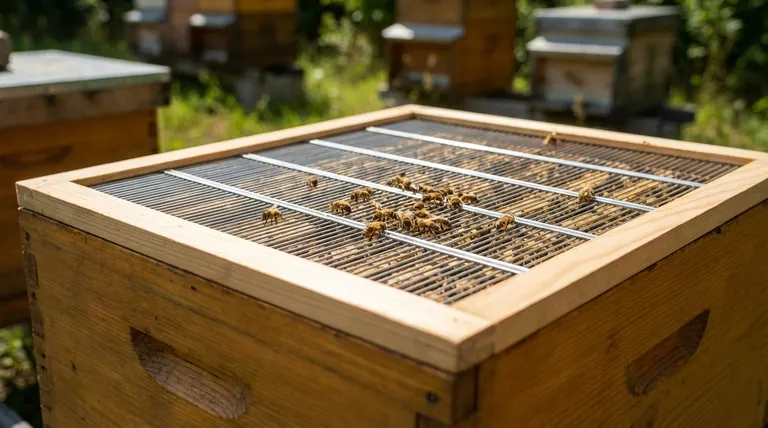In essence, a queen excluder is a specialized sieve for bees. It is a perforated grid, made of metal or plastic, placed between sections of a beehive. Its primary purpose is to confine the queen bee to the lower part of the hive, the brood chamber, while allowing the smaller worker bees to pass through to the upper honey storage areas, known as honey supers.
The core function of a queen excluder is to enforce hive organization. By separating the queen's egg-laying area from the honey storage area, it ensures a cleaner, easier honey harvest and simplifies hive management for the beekeeper.

The Principle: Separating Brood from Honey
A modern beehive is managed in a stack of boxes. The bottom boxes are for the queen to lay eggs and raise brood, while the top boxes are intended for honey storage. The queen excluder is the tool that enforces this division.
How an Excluder Works
The device operates on a simple principle: size.
The slots or holes in the excluder are engineered to be large enough for worker bees to pass through but too small for the larger queen and drones to squeeze through. This creates a selective barrier.
This design effectively filters bee traffic between the brood chamber and the honey supers, ensuring only the honey-producing workers can access the upper levels.
The Goal: A Dedicated Brood Nest
By confining the queen, the excluder ensures the brood nest—where eggs, larvae, and pollen are stored—remains in the lower boxes.
This prevents the queen from laying eggs in the frames designated for honey collection, a critical step for efficient beekeeping.
Key Benefits of Using a Queen Excluder
Using an excluder is a strategic choice with distinct advantages for the beekeeper, primarily centered on efficiency and control.
Purity and Ease of Harvest
When the queen lays eggs in honey frames, the resulting comb contains not just honey but also larvae, pupae, and their shed skins.
An excluder guarantees that frames in the honey supers contain only honey. This makes the extraction process cleaner, faster, and yields a higher quality product.
Simplified Hive Management
Knowing the queen is confined to the brood boxes makes hive inspections more predictable.
Beekeepers can manage the honey supers without the constant risk of accidentally harming the queen, who is the single most important bee in the colony.
Specialized Applications
Beyond honey production, excluders are used for more advanced beekeeping techniques.
These include producing royal jelly or managing multi-queen colonies, where precise control over the queen's location is essential.
Understanding the Trade-offs
While effective, a queen excluder is a controversial tool among beekeepers because it interferes with the bees' natural movement. It is not without its potential downsides.
Potential for Reduced Honey Production
The barrier can create a bottleneck. Worker bees may be hesitant to cross it, or they may be slowed down as they navigate the grid.
This reluctance, sometimes called the "honey barrier" effect, can lead to less honey being stored in the supers and more being packed into the brood chamber, potentially crowding the queen.
Risk of Physical Harm
The metal or plastic edges of the excluder can be abrasive.
Worker bees, especially when carrying large loads of pollen, can scrape their wings or bodies while squeezing through, which can shorten their productive lifespan.
Making the Right Choice for Your Goal
Deciding whether to use a queen excluder depends entirely on your beekeeping philosophy and objectives.
- If your primary focus is maximum honey purity and harvesting efficiency: An excluder is an invaluable tool that guarantees brood-free honey frames.
- If your primary focus is a more natural, less intrusive approach: You might choose to forgo an excluder and instead manage the queen's laying patterns through careful monitoring.
- If you are a new beekeeper seeking a predictable system: An excluder provides a clear structure that can make learning to manage a hive much easier.
Ultimately, the queen excluder is a strategic management tool that allows you to tailor the hive's structure to your specific goals.
Summary Table:
| Feature | Purpose | Key Benefit |
|---|---|---|
| Selective Barrier | Confines the queen to the brood chamber | Prevents eggs in honey supers, ensuring pure honey |
| Hive Organization | Separates brood nest from honey storage area | Simplifies hive inspections and management |
| Size-Based Design | Allows worker bees to pass, blocks queen/drones | Enforces a dedicated space for honey production |
Ready to optimize your apiary's efficiency?
HONESTBEE supplies professional-grade queen excluders and a full range of beekeeping supplies to commercial apiaries and distributors. Our wholesale-focused operations ensure you get the durable, effective equipment you need to manage your hives for maximum honey purity and yield.
Contact HONESTBEE today to discuss your wholesale needs and elevate your beekeeping operation.
Visual Guide

Related Products
- Premium Wood Framed Metal Wire Queen Bee Excluder
- Professional Plastic Queen Excluder for Modern Beekeeping
- Plastic Queen Bee Excluder for Bee Hive Wholesale
- High Performance Plastic Queen Excluder for Beekeeping and Apiary Management
- Wooden Queen Bee Excluder for Beekeeping
People Also Ask
- What considerations should a beekeeper take into account when deciding whether to use an excluder?
- What makes polyurethane foam environmentally friendly? The Surprising Benefits of a Durable, Inert Material
- What is the primary function of a queen excluder? A Guide to Brood-Free Honey Harvesting
- What are the advantages of using a queen excluder? Maximize Honey Yield & Hive Control
- When to put queen excluder on hive? Key Timing for Maximum Honey Production



















